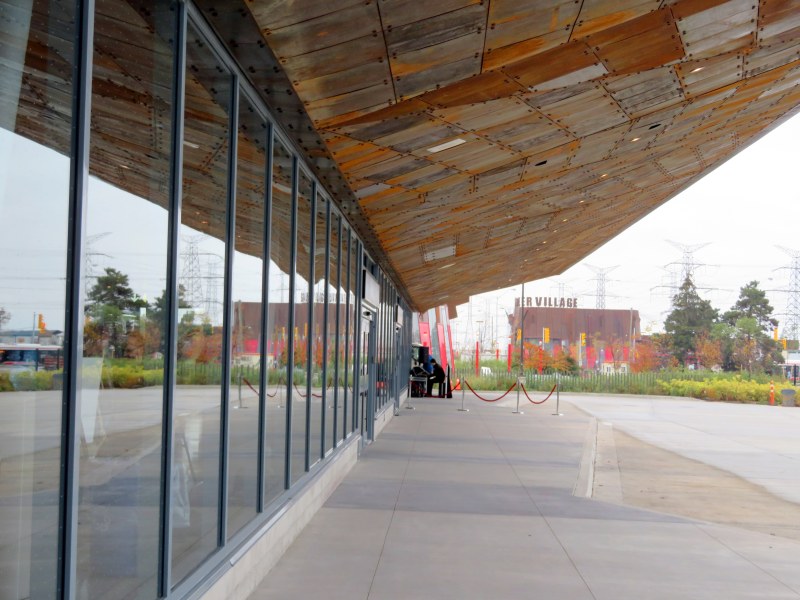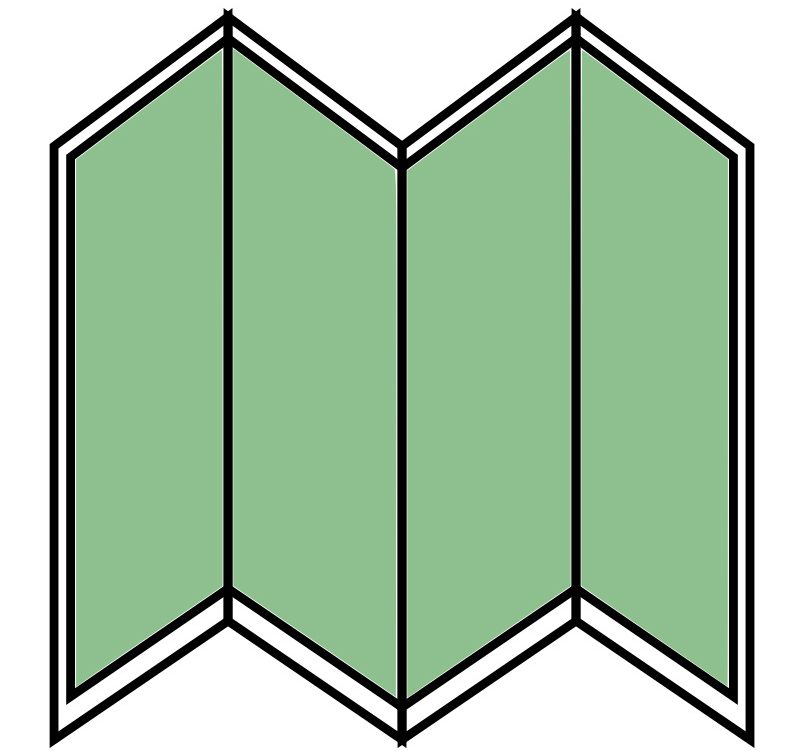 Vaughan Metropolitan Centre Station
Vaughan Metropolitan Centre Station
On Saturday, October 28, the Toronto Transit Commission (TTC) held open houses at three of the six new subway stations set to open on December 17, 2017 when the Line 1 subway is extended to York University and Vaughan. It was a fun afternoon with friends, checking out the architecture and the layout of Vaughan Metropolitan Centre,* Highway 407, and Pioneer Village Stations.
Some of the station architecture was stunning, and I came away feeling much less skeptical about Vaughan’s commitment to building a new urban district around its station. Most stations along the subway corridor will be well-used. However, I remain critical about the issue of transfers between transit agencies, and the usefulness of at least one station.
Vaughan Metropolitan Centre
The most northerly station, designed by Arup Canada and Grimshaw Architects, is a lovely new facility – despite the rain and overcast skies, the station was surprisingly bright; reflective metal ceilings and lots of natural and artificial light make it quite pleasant. The large mezzanine level not only connects to several exits and bus transfers, it is also designed for a small-scale PATH system of connecting tunnels to planned development. 
Despite Vaughan’s poor record of supporting transit and sustainable development, the plans for the area around the new station are impressive. One new office building, housing KPMG, has been built; new condominium towers are under construction or are planned. Much of the surrounding land is owned by Smart REIT, best known for auto-centric big box developments, but the site plan here is much more progressive.
 Long-term plans for the area around Vaughan Metropolitan Station
Long-term plans for the area around Vaughan Metropolitan Station
New condominiums and a few new office buildings alone will not support the ridership needed for the subway station, though good local transit can accomplish this. However, I am more skeptical about that.
York Region Transit (local buses and Viva Orange) and Brampton Transit (Route 501 Queen Züm) will serve the stop from two separate facilities outside the fare-paid area. Züm and Viva buses will stop in a new Rapidway Station in the middle of Highway 7 (which will have direct subway station access), while local YRT routes 10, 20, and 26 will stop north of the station, at a large bus loop called “SmartCentres Place Bus Terminal.” Route 77, the local Highway 7 bus, will stop at regular curb-side bus stops. Passengers connecting between Viva/Züm and local YRT buses at Vaughan Centre will face a lengthy walk.
 The long corridor to the “SmartCentres Place Bus Terminal”
The long corridor to the “SmartCentres Place Bus Terminal”
I wrote about the problems with the new Viva Rapidways — and poor York Region Transit service in Spacing Toronto back in 2013, but little has changed. Poor transit frequencies in York Region limit the utility of new bus rapid transit and subway infrastructure. The TTC can generate respectable ridership at suburban subway stations because of strong bus connections; York Region Transit will need to step up to do the same in Vaughan.

The TTC station site plan shows the Rapidway station (Viva, Züm) and the bus loop for local YRT buses (source)
I also noticed that TTC signage at the new Vaughan station did not include directions to Brampton Transit Züm buses, which will serve the Rapidway. The TTC responded to my tweet, first suggesting that Brampton buses wouldn’t stop here, then claiming that YRT is responsible for the misinformation. I hope this is rectified by December 17.
Highway 407 Station

The bus terminal has the appearance of a mid-sized airport terminal
Unlike Vaughan Metropolitan Centre, Highway 407 Station will neither have any walk-in passengers, nor will it ever generate any transit-oriented development. The station is adjacent to the Jane Street/Highway 407 interchange, under a major hydro-electric corridor, and is across the street from a large cemetery. The new station will be useful only as transfer point for GO Transit and YRT buses, and commuters parking at a 608-spot surface lot.
So far, GO Transit has not announced how it will serve the subway extension, even though the TTC, YRT and Brampton Transit have made their plans public. Unlike those three local transit agencies, GO Transit and its parent agency, Metrolinx, did not participate in the open houses.
 Part of the gigantic GO Transit bus terminal at Highway 407 Station
Part of the gigantic GO Transit bus terminal at Highway 407 Station
Originally, the plans were for GO Transit buses that currently serve York University to terminate at Highway 407 Station instead; GO Transit was allocated 18 bays at the station’s bus terminal. York University students and employees would have had to transfer to the subway to get to the nearby campus, but through Highway 407 passengers would have benefited from a faster connection. As there are no fare integration plans between GO Transit and the TTC, apart from a recently-announced announced $1.50 discounted co-fare, GO buses will continue to serve the campus after the subway opens.
 Highway 407 Station is especially striking — but how many people will actually see it?
Highway 407 Station is especially striking — but how many people will actually see it?
Until it is used as its full potential as a major regional bus hub, Highway 407 Station will be a white elephant. And that’s a shame, because it’s a very attractive station. The bus terminal itself looks like a modern airport (more so than even the bus terminal at Sheppard West, formerly Downsview), while the interior is reminiscent of several Montreal Metro stations, with bright coloured glass and a deep descent to the subway platforms.

A friend compared David Pearl’s coloured glass works to Champ-de-Mars Station in Montreal
Pioneer Village Station
 North entrance to Pioneer Village Station; the YRT terminal is behind
North entrance to Pioneer Village Station; the YRT terminal is behind
Pioneer Village Station is on Steeles Avenue West, the border of the City of Toronto and the City of Vaughan, York Region. It’s also adjacent to the northern boundary of York University’s campus. The station features two bus terminals: the north side, in Vaughan, will be served by York Region Transit, which will operate six bus routes into one terminal outside the TTC fare-paid area; the south terminal, inside the fare-paid area, will be served by eight TTC routes. These bus connections will drive most of the passenger traffic at Pioneer Village Station, though several York University campus buildings — especially sports and athletic facilities — are closer to here than to York University Station. Black Creek Pioneer Village, the station’s namesake, is about a 10 minute walk away. There is also a 1,881-car parking lot on the north side, under the hydro-electric corridor.
 Architect Will Alsop was quietly — and mostly inconspicuously — watching visitors admire his firm’s architecture at Pioneer Village Station.
Architect Will Alsop was quietly — and mostly inconspicuously — watching visitors admire his firm’s architecture at Pioneer Village Station.
Architecturally, Pioneer Village is my favourite of all the new subway stations. Cor-ten steel is used to great effect; it contrasts well with the bright red panels. The skylights and lighting fixtures are interesting. Still being installed is “LightSpell” by Jim and Jan Elder, which allows messages to be broadcast on light fixtures that appear like old LCD displays found on calculators or early digital instruments. The lead architect is aLL Design, a global firm led by Will Alsop.
 TTC bus terminal at Pioneer Village Station
TTC bus terminal at Pioneer Village Station
Concluding thoughts
Of all the six new stations, I believe that Finch West and Pioneer Village Station will be well used because of the TTC surface route connections. Finch West also has moderate residential density, including nearby high-rise apartments, that will also contribute to respectable ridership. The extension will also provide some (but not enough) relief to the Yonge Subway by intercepting bus passengers travelling east on Steeles and Finch Avenues. The TTC subway is a success largely because of its convenient and easy bus connections.

TTC bus changes coinciding with the subway extension (source)
York University Station, will, of course, be well-used during the academic year, with lulls during the summer and the winter holiday season. It will also be the main transfer point with Brampton Transit and several YRT routes. Vaughan Metropolitan Centre Station has potential, but it requires York Region to commit to funding better transit, and to Vaughan for seeing their grand urban vision fulfilled.
But Downsview Park will — for the short-term at least — be poorly used. GO Transit rail service on the Barrie Line operates only during rush hours, and on a less-than-hourly schedule on weekends. This will likely change, however, once frequent all-day GO service, or GO RER is implemented. There are no direct TTC bus connections, and only a few industries within walking distance. Except during special events, Downsview Park will generate very few riders. And until GO Transit releases their plans for serving the subway extension, Highway 407 Station runs the risk of making Bessarion Station look crowded in comparison.
* I detest the name “Vaughan Metropolitan Centre, mainly because it’s just too long and difficult to fit on a map. It’s also a product of local politics, as Vaughan and York Region demanded the name despite TTC objections. But that ship has sailed.
